Nice idea for an AAR. I'll be watching, because I honestly don't know how you're going to pull it off. 
The Roof of the World: A Tibetan AAR
- Thread starter Eärendil
- Start date
-
We have updated our Community Code of Conduct. Please read through the new rules for the forum that are an integral part of Paradox Interactive’s User Agreement.
You are using an out of date browser. It may not display this or other websites correctly.
You should upgrade or use an alternative browser.
You should upgrade or use an alternative browser.
Chapter 4

Since Sikkim does not have any kind of army, it was in theory a simple task to annex their country. All that is needed is to occupy their single province and proclaim Dalai Lama their new overlord. So, with hopes high our new cavalry unit under General Raman starts marching into Gangtok and starts occupying the province. However, this proved to be a lot harder in reality, and it was not until August 15, 1841, more than 6 months later, that the province was fully occupied and could be incorporated into the Tibetan empire.

The “expedition” had not been a walk in the park either; about 1,700 Tibetans had lost their lives in the campaign. Dalai Lama only gave the soldiers 3 days of rest and mourning before sending another declaration of war. This time to Bhutan.
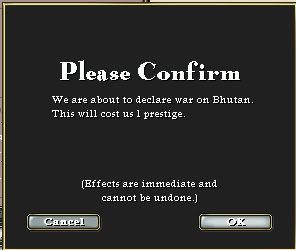
Bhutan had an army consisting of a thousand irregulars, guarding the capital. As the 8,300 men strong Tibetan army approached, they refused to succumb and engaged the Tibetans in defense of the city.
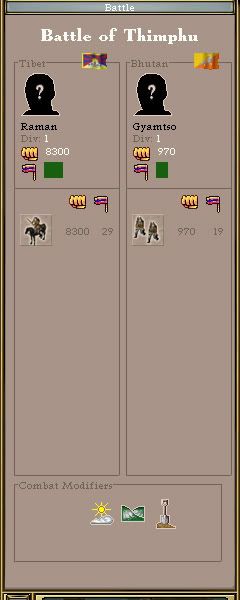
The battle lasted for more than 2 months before the brave Bhutanese finally surrendered. The Bhutanese had almost fought to their last man, while almost 2,000 Tibetans had died of the battle.
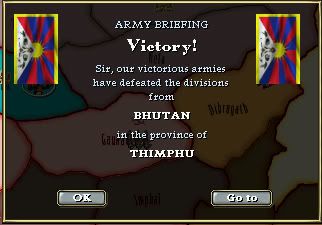
It took another 5 months before the province was fully occupied and Bhutan was incorporated into the empire.
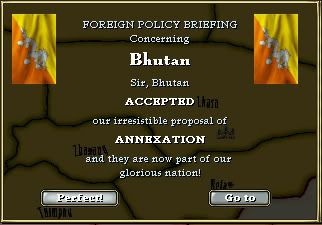
During the Bhutanese campaign, a treaty was signed between Britain and China, giving Britain control over many Chinese ports, but more importantly, ending the conflict and the area was stable once again.
Now, with Bhutan and Sikkim annexed, Tibet had a population slightly over 3,800,000 men. We also no longer had to rely on a single source of income because now we were producing sheep and yak, instead of just yak.
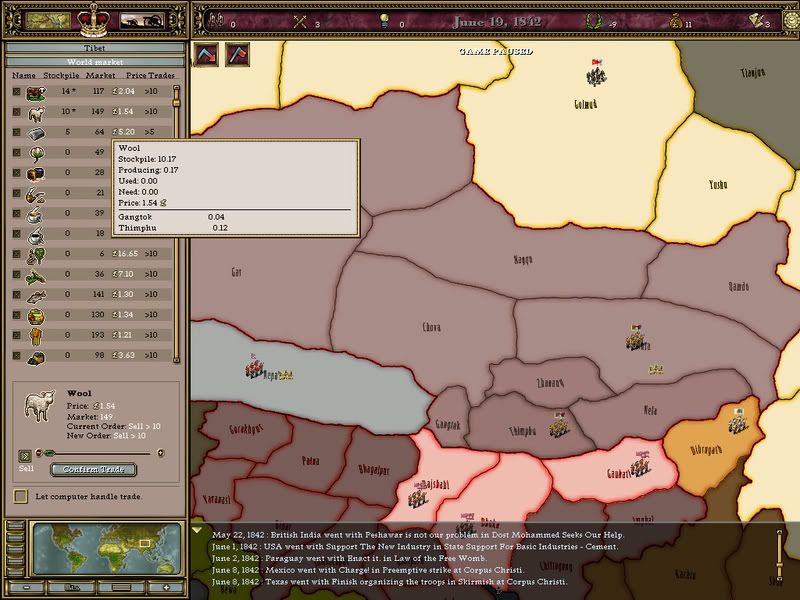
Here is also the new border between British India and Tibet after the Tibetan annexation of Bhutan and Sikkim.
Don’t miss the next chapter, where we will see a period of peace before going to war again. I'll leave it up to you, the readers, to guess who our next enemy will be.

Since Sikkim does not have any kind of army, it was in theory a simple task to annex their country. All that is needed is to occupy their single province and proclaim Dalai Lama their new overlord. So, with hopes high our new cavalry unit under General Raman starts marching into Gangtok and starts occupying the province. However, this proved to be a lot harder in reality, and it was not until August 15, 1841, more than 6 months later, that the province was fully occupied and could be incorporated into the Tibetan empire.

The “expedition” had not been a walk in the park either; about 1,700 Tibetans had lost their lives in the campaign. Dalai Lama only gave the soldiers 3 days of rest and mourning before sending another declaration of war. This time to Bhutan.

Bhutan had an army consisting of a thousand irregulars, guarding the capital. As the 8,300 men strong Tibetan army approached, they refused to succumb and engaged the Tibetans in defense of the city.

The battle lasted for more than 2 months before the brave Bhutanese finally surrendered. The Bhutanese had almost fought to their last man, while almost 2,000 Tibetans had died of the battle.

It took another 5 months before the province was fully occupied and Bhutan was incorporated into the empire.

During the Bhutanese campaign, a treaty was signed between Britain and China, giving Britain control over many Chinese ports, but more importantly, ending the conflict and the area was stable once again.
Now, with Bhutan and Sikkim annexed, Tibet had a population slightly over 3,800,000 men. We also no longer had to rely on a single source of income because now we were producing sheep and yak, instead of just yak.

Here is also the new border between British India and Tibet after the Tibetan annexation of Bhutan and Sikkim.
Don’t miss the next chapter, where we will see a period of peace before going to war again. I'll leave it up to you, the readers, to guess who our next enemy will be.
The reason I declared war on Sikkim first was because the cost of a DoW is connected to the relative prestige between the attacker and the defender. Had I gone to war against Bhutan first, I would gain 4 prestige, -1 for the DoW and +5 for the annexation. Thus the DoW on Sikkim would cost more had I annexed Bhutan first.
By looking at how many men we lost in the battle and how long it took to occupy a province, you can tell that our army is really weak without any military techs.
Indeed it does!
Yes, that event will indirectly speed up our civilizing process with years. You will see.
I'm afraid we still have a few years left on our first tech, but don't underestimate the power of Dalai Lama.
Don't worry, I will explain it in details.
rcduggan: Thank you for your comment.
By looking at how many men we lost in the battle and how long it took to occupy a province, you can tell that our army is really weak without any military techs.
Raden Shaka said:Ah... First step of conquest. Smells nice...
Indeed it does!
stnylan said:An important first step by the sounds of it. That cavalry event was very welcome.
Yes, that event will indirectly speed up our civilizing process with years. You will see.
Dysken said:Good job. I hope your research is going into industrial techs at the moment. You'll need mechanized production if you are going to have an economy good enough to support your efforts.
I'm afraid we still have a few years left on our first tech, but don't underestimate the power of Dalai Lama.
Vladislav said:Nice idea for an AAR. I'll be watching, because I honestly don't know how you're going to pull it off.
Don't worry, I will explain it in details.
rcduggan: Thank you for your comment.
Punjab might be the economically sound decision. But if IIRC the BEIC has cores on them so it might not be the wise thing to do. Although since they have mil access to you, you could probably invade Punjab and when they/if they cancel mil access you release punjab as a satellite to see what happens. Also, having a large non national population is actually useful when trying to civilize as you can focus on getting your national pops to become clergymen while the foreigners toil away in the salt mines.
Who's next? Who's next? Nepal, of course! Occupy Kathmandu and form your own Gurkha Infantry!! 
But, considering if the Nepalese are allied to the EIC, that would be tough. Perhaps Annam? Grabbing some lands from them would be tempting. Btw, congratulations on your success on Sikkim and Bhutan Expeditions. Thousands of Tibetan might have lost their lives, but it's all fair in lov... I mean, conquest, and war.
But, considering if the Nepalese are allied to the EIC, that would be tough. Perhaps Annam? Grabbing some lands from them would be tempting. Btw, congratulations on your success on Sikkim and Bhutan Expeditions. Thousands of Tibetan might have lost their lives, but it's all fair in lov... I mean, conquest, and war.
Vladislav said:Nice idea for an AAR. I'll be watching, because I honestly don't know how you're going to pull it off.
I will be watching for exactly the same reason.
Is it even possible to meet all the requirements in order to civilize Tibet?
Chapter 5

Shortly after the war our literacy reaches 8 percent and our research point generation rate takes a new small leap. We are showing steady progress!

Since the war, steady unrest had been growing in our newly acclaimed provinces and on September 10, 1843, several hundred Nepalese in Gangtok took up arms and tried to liberate their country again. Dalai Lama realized however that the uprising was just too weak and decided to wait the rebels out until the province was calm again. This proved to be a good strategy as the Nepalese now saw him as a merciful man.

On November 12, 1844, our education funding finally paid off a little. Our first tech Water-wheel power was researched and we could start focusing on researching another tech.
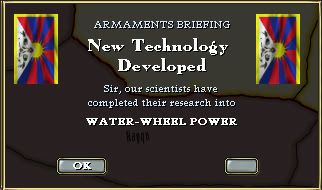
Dalai Lama decided to go for Flintlock Rifles, as it would enable him to build professional, regular units of three different types; infantry, cavalry and dragoons. Despite living high up in the mountains, Dalai Lama preferred cavalry.
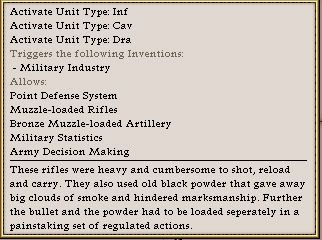
With the new tech researched, Dalai Lama decided to revise the budget again.
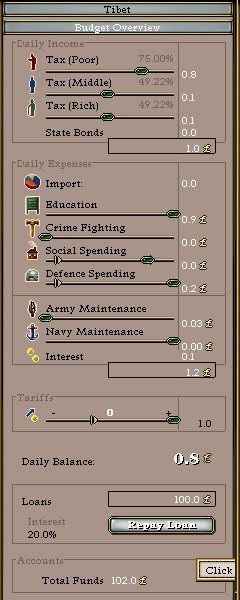
In order to pay off the debts we had acquired during the war, Dalai Lama cut Army maintenance and we were now making a steady surplus of .8 £ per day. This however, meant that both our armies were cut in size and could only field 1,900 men each.
In 1845, Tibetan scientists were lucky enough to make an unexpected invention, speeding up our research progress immediately.
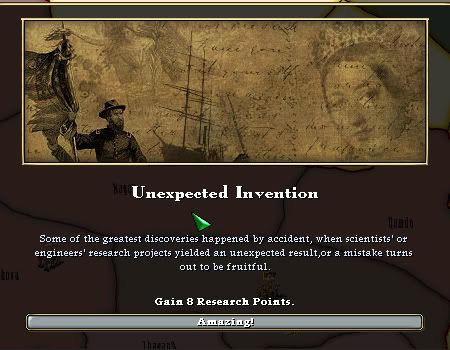
While we had to cut our military budget, British India did the opposite and decided to go for the independent Indian nations, Sindh and Punjab. We hope we are not next in line.

The unexpected invention had proved really significant for our research and on February 17, 1846, our second tech was researched. While our first tech had taken nearly 9 years to complete, our second was done in about 15 months. As for the third tech, Dalai Lama decided to go for Free Trade, an economical tech.

It was not an easy choice, for the key to quick modernization is to go for the industrial techs first. Another possibility was to research Malthusian Thought, which is required to research Positivism and Functionalism, both which will give a +10% research point generation rate. However, the +105% Cattle efficiency could not be neglected and thus we decided to go for Free Trade. The yaks have a special place in a Tibetan man's heart.
All was going well until British-Chinese relations once again plummeted and war erupted.
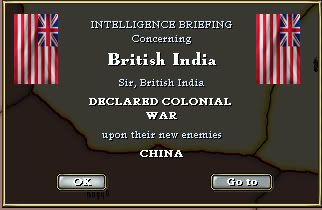
How will Tibet go through another major conflict in the area? Find out in the next chapter, of course.

Shortly after the war our literacy reaches 8 percent and our research point generation rate takes a new small leap. We are showing steady progress!

Since the war, steady unrest had been growing in our newly acclaimed provinces and on September 10, 1843, several hundred Nepalese in Gangtok took up arms and tried to liberate their country again. Dalai Lama realized however that the uprising was just too weak and decided to wait the rebels out until the province was calm again. This proved to be a good strategy as the Nepalese now saw him as a merciful man.

On November 12, 1844, our education funding finally paid off a little. Our first tech Water-wheel power was researched and we could start focusing on researching another tech.

Dalai Lama decided to go for Flintlock Rifles, as it would enable him to build professional, regular units of three different types; infantry, cavalry and dragoons. Despite living high up in the mountains, Dalai Lama preferred cavalry.

With the new tech researched, Dalai Lama decided to revise the budget again.

In order to pay off the debts we had acquired during the war, Dalai Lama cut Army maintenance and we were now making a steady surplus of .8 £ per day. This however, meant that both our armies were cut in size and could only field 1,900 men each.
In 1845, Tibetan scientists were lucky enough to make an unexpected invention, speeding up our research progress immediately.

While we had to cut our military budget, British India did the opposite and decided to go for the independent Indian nations, Sindh and Punjab. We hope we are not next in line.

The unexpected invention had proved really significant for our research and on February 17, 1846, our second tech was researched. While our first tech had taken nearly 9 years to complete, our second was done in about 15 months. As for the third tech, Dalai Lama decided to go for Free Trade, an economical tech.

It was not an easy choice, for the key to quick modernization is to go for the industrial techs first. Another possibility was to research Malthusian Thought, which is required to research Positivism and Functionalism, both which will give a +10% research point generation rate. However, the +105% Cattle efficiency could not be neglected and thus we decided to go for Free Trade. The yaks have a special place in a Tibetan man's heart.
All was going well until British-Chinese relations once again plummeted and war erupted.

How will Tibet go through another major conflict in the area? Find out in the next chapter, of course.
Decided to throw in an additional update today as the last one was rather short.
Nothing special to report in the update, except that we were lucky enough to gain an event that will save us quite a lot of time on research.
I'm afraid we weren't strong enough to take on Punjab before British India went for them, but had we had the strength, they would probably be the #1 target. About the latter part, we might see some of it in a not so distant future .
.
Thank you for the congratulations. I'm afraid Annam is a little distant from us, we can only declare war on our neighbours, but otherwise they would indeed be a tempting target. Nepal is not allied to British India, however, they have a mountainous and forested province which can be quite tough to attack.
 .
.
likk9922 & stnylan: Thank you for your comments.
Nothing special to report in the update, except that we were lucky enough to gain an event that will save us quite a lot of time on research.
Dysken said:Punjab might be the economically sound decision. But if IIRC the BEIC has cores on them so it might not be the wise thing to do. Although since they have mil access to you, you could probably invade Punjab and when they/if they cancel mil access you release punjab as a satellite to see what happens. Also, having a large non national population is actually useful when trying to civilize as you can focus on getting your national pops to become clergymen while the foreigners toil away in the salt mines.
I'm afraid we weren't strong enough to take on Punjab before British India went for them, but had we had the strength, they would probably be the #1 target. About the latter part, we might see some of it in a not so distant future
Raden Shaka said:Who's next? Who's next? Nepal, of course! Occupy Kathmandu and form your own Gurkha Infantry!!
But, considering if the Nepalese are allied to the EIC, that would be tough. Perhaps Annam? Grabbing some lands from them would be tempting. Btw, congratulations on your success on Sikkim and Bhutan Expeditions. Thousands of Tibetan might have lost their lives, but it's all fair in lov... I mean, conquest, and war.
Thank you for the congratulations. I'm afraid Annam is a little distant from us, we can only declare war on our neighbours, but otherwise they would indeed be a tempting target. Nepal is not allied to British India, however, they have a mountainous and forested province which can be quite tough to attack.
Find out by reading this AARBurningEGO said:I will be watching for exactly the same reason.
Is it even possible to meet all the requirements in order to civilize Tibet?
likk9922 & stnylan: Thank you for your comments.
For those of you who are unaware of the new civilizing requirements for VIP:R, here's the full list of requirements:
Code:
Indirect civilizing requirements in VIP:R
10 Prestige
6 Military score
Techs:
Army:
1401 The Command Principle
1402 Army Professionalism
Navy:
2401 The Command Principle
2402 Navy Professionalism
Commerce:
3001 Private Banks
3101 No Standard
3102 Ad-Hoc Money Bill Printing
3301 Freedom of Trade
3302 Market structure
Culture:
4103 Empiricism
4102 Idealism
4101 Late Enlightenment Philosophy
4001 Classicism & Early Romanticism
4201 Malthusian Thought
4301 Enlightenment Thought
4401 Introspectionism
4302 Ideological Thought
4303 State & Government
Industry:
5302 Early Railroad
5301 Experimental Railroad
5002 Practical Steam Engine
5001 Water-wheel Power
5202 Clean Coal
5201 Mechanized MiningEärendil said:For those of you who are unaware of the new civilizing requirements for VIP:R, here's the full list of requirements:
Thats cheap.
Oh and thanks for posting them - i for one didnt imagine the requirements would be diferent with VIP.
Chapter 6

The second war between British India and China had not been going on for many months before Dalai Lama had gathered enough courage to make his bravest and boldest decision ever.
On February 15, 1849, Dalai Lama sent an official declaration of war… to China.
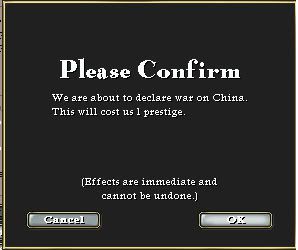

When the news reached the Tibetan peasants, they reacted with horror. Had Dalai Lama gone mad?
All they knew about China was from the stories of their ancestors; tales of enormous armies ravaging the countryside, killing and pillaging.
Fortunately, Dalai Lama had more information about China than they had, and he had a cunning plan in his mind.
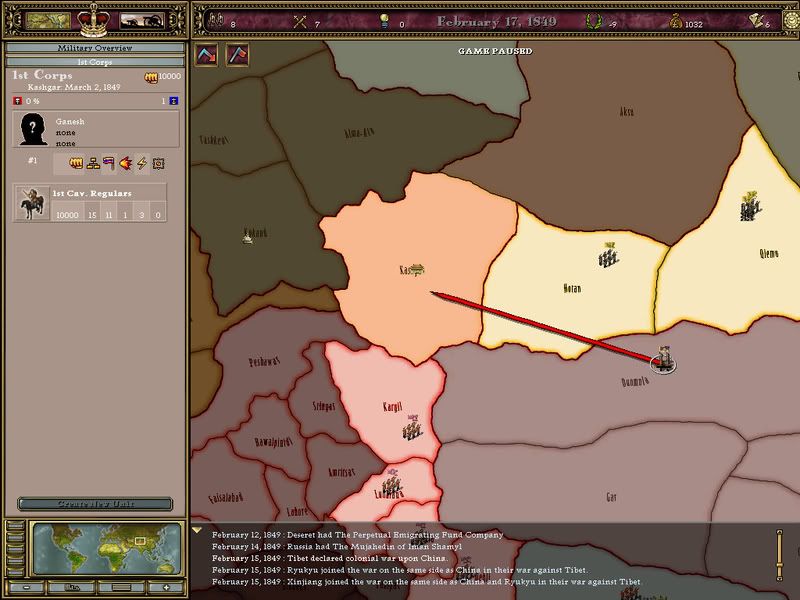
His cavalry division was reinforced to maximum strength once again and ordered to set for Xinjiang’s capital, Kashgar.
Meanwhile, the 1,900 men strong army of irregulars was left to defend Dalai Lama in the Royal Palace in Lhasa.
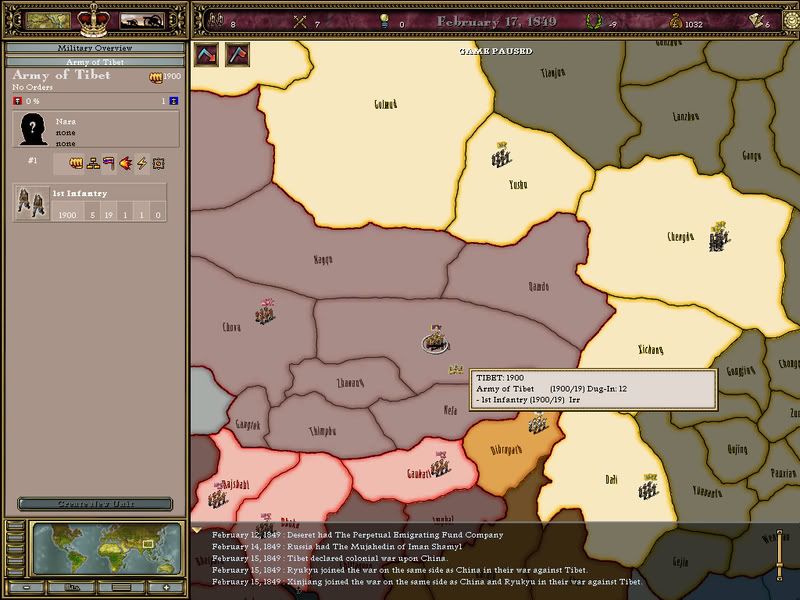
After a few months without much progress, a Chinese army consisting of 20,000 men was seen heading for the Tibetan capital. Dalai Lama was troubled; he had not anticipated that China could divert such a large portion of their army from their war against Britain. However, there was nothing he could do about it than to prepare the city defenses and strengthen the morale of his troops.
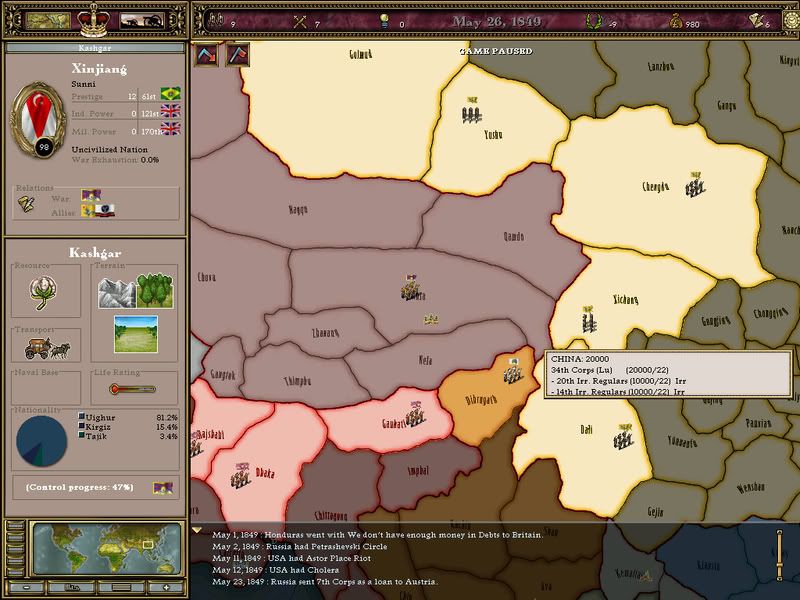
On July 22, 1849, the 20,000 men strong army under the General Lu approached the city and engaged the defenders in combat. The attackers were outnumbering the small Tibetan army more than tenfold, how long would the Tibetans endure such an assault? Trapped inside his palace, Dalai Lama was more troubled than ever before.
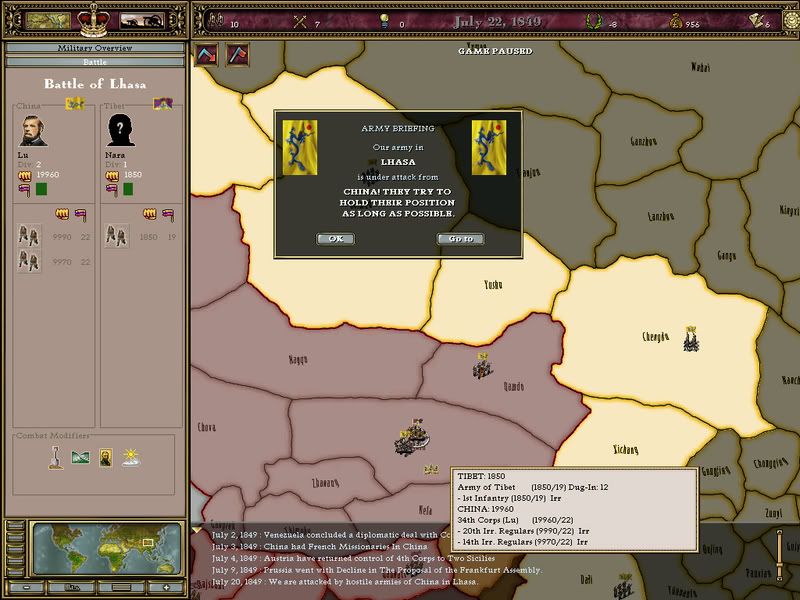
On September 12, about two months later, less than a thousand Tibetans were left to defend the city, while having inflicted nearly 3,500 casualties on the Chinese. It was in this darkest hour that a messenger reached the palace in Lhasa. The city of Kashgar, capital of Xinjiang, had been taken, but more importantly, the Chinese emperor had been captured!
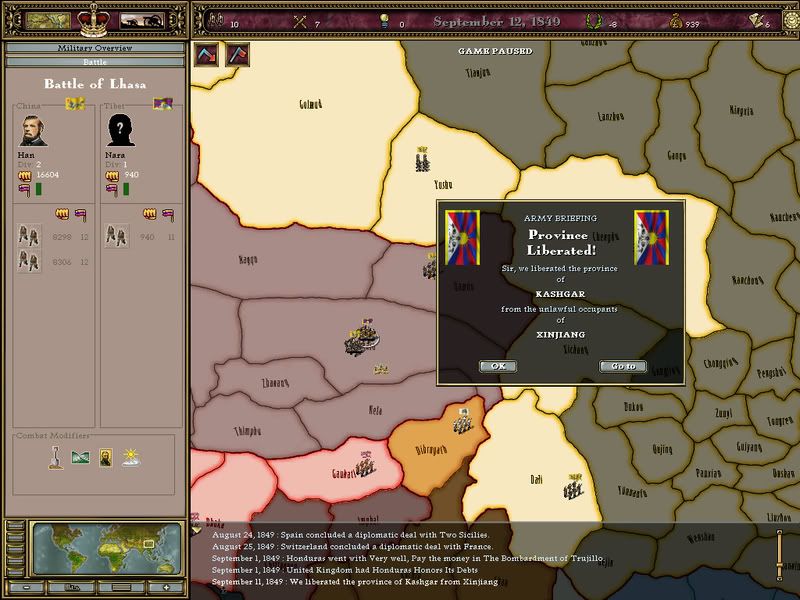
So, with a treaty in his hands, Dalai Lama walked out of the city to meet with General Han, who had replaced General Lu during the battle (or was it General Lu with a new name; the Tibetans could not tell because they looked exactly the same). When Dalai Lama was approaching, General Han thought that the Tibetans were surrendering, but when he saw that the Chinese emperor had signed a treaty giving Tibet half of their monthly income at the first of every month for three years from now on, his head exploded (well, not literally).

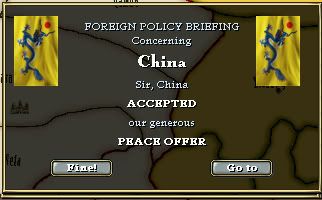
Dalai Lama’s daring plan had paid off, leaving Tibet in a better situation than ever before. With Chinese gold filling their coffins, there were endless possibilities on how to proceed. However, it had been very close that the gamble had failed and Dalai Lama wished not to take too many risks now that he was on stable ground. After all, many Tibetans had died to gather the information about how the Chinese emperor had fled to Xinjiang in order to prevent himself from being captured by the British. Dalai Lama knew that they were in for some hard years before they could capitalize on this.
What exactly will Dalai Lama do with the Chinese money? Find out in the next chapter.

The second war between British India and China had not been going on for many months before Dalai Lama had gathered enough courage to make his bravest and boldest decision ever.
On February 15, 1849, Dalai Lama sent an official declaration of war… to China.


When the news reached the Tibetan peasants, they reacted with horror. Had Dalai Lama gone mad?
All they knew about China was from the stories of their ancestors; tales of enormous armies ravaging the countryside, killing and pillaging.
Fortunately, Dalai Lama had more information about China than they had, and he had a cunning plan in his mind.

His cavalry division was reinforced to maximum strength once again and ordered to set for Xinjiang’s capital, Kashgar.
Meanwhile, the 1,900 men strong army of irregulars was left to defend Dalai Lama in the Royal Palace in Lhasa.

After a few months without much progress, a Chinese army consisting of 20,000 men was seen heading for the Tibetan capital. Dalai Lama was troubled; he had not anticipated that China could divert such a large portion of their army from their war against Britain. However, there was nothing he could do about it than to prepare the city defenses and strengthen the morale of his troops.

On July 22, 1849, the 20,000 men strong army under the General Lu approached the city and engaged the defenders in combat. The attackers were outnumbering the small Tibetan army more than tenfold, how long would the Tibetans endure such an assault? Trapped inside his palace, Dalai Lama was more troubled than ever before.

On September 12, about two months later, less than a thousand Tibetans were left to defend the city, while having inflicted nearly 3,500 casualties on the Chinese. It was in this darkest hour that a messenger reached the palace in Lhasa. The city of Kashgar, capital of Xinjiang, had been taken, but more importantly, the Chinese emperor had been captured!

So, with a treaty in his hands, Dalai Lama walked out of the city to meet with General Han, who had replaced General Lu during the battle (or was it General Lu with a new name; the Tibetans could not tell because they looked exactly the same). When Dalai Lama was approaching, General Han thought that the Tibetans were surrendering, but when he saw that the Chinese emperor had signed a treaty giving Tibet half of their monthly income at the first of every month for three years from now on, his head exploded (well, not literally).


Dalai Lama’s daring plan had paid off, leaving Tibet in a better situation than ever before. With Chinese gold filling their coffins, there were endless possibilities on how to proceed. However, it had been very close that the gamble had failed and Dalai Lama wished not to take too many risks now that he was on stable ground. After all, many Tibetans had died to gather the information about how the Chinese emperor had fled to Xinjiang in order to prevent himself from being captured by the British. Dalai Lama knew that they were in for some hard years before they could capitalize on this.
What exactly will Dalai Lama do with the Chinese money? Find out in the next chapter.
Actually, I was myself unsure whether this strategy would pay off or not. Occupying any capital of your enemies in a war (uncivilized or not) gives you a +20% warscore against the leader of the alliance. Thus, it may prove a good strategy to refrain from signing seperate peace treaties with a strong enemy's allies, as it might give you a much better peace deal from the alliance leader. In this case, the 21% I gained from occupying Kashgar was enough to make China accept my terms. Usually, asking for such treaties will take at least 2 or 3 tries, but I was lucky that they accepted on the first attempt. It may have been because they were in a war against British India, because maybe they wouldn't have accepted the treaty at all if they were solely fighting me.
I was also very surprised on how well my irregulars did in defending Lhasa. I chose not to reinforce the unit because the morale would've dropped to 0 immediately, and it takes a lot of time for it to recover when you don't have many military techs (1 in this case).
I was also very surprised on how well my irregulars did in defending Lhasa. I chose not to reinforce the unit because the morale would've dropped to 0 immediately, and it takes a lot of time for it to recover when you don't have many military techs (1 in this case).
Nice move with striking the Chinese, however is there anyway to gain more territory out of your next few wars? Money can get you very far, but you need a stable base get gain more.
Wealth of China is coming in! That's nice. War against China was a risky gamble, though...
Great AAR Eärendil! Never thought you would survive that war with the chinese, but you pulled through. 
First I thought you had gone crazy, then I thought you were cheating, but now I see that the war and subsequent peace with China was actually a very clever gambit on your part. 

